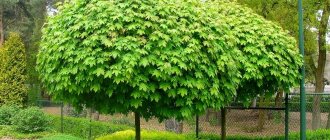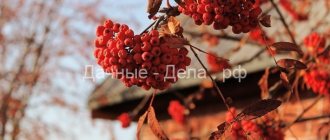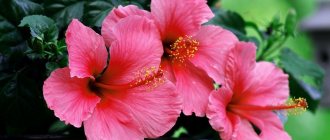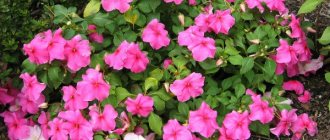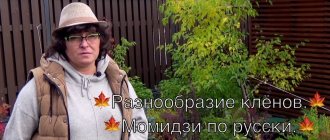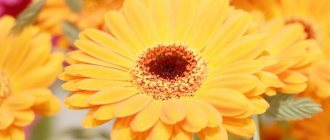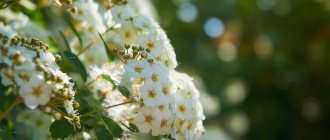Field maple - varieties, propagation, grafting and proper care
- View the full image
Field maple
General information about field maple
Care and planting
Reproduction
Maple grafting
Diseases and pests
In landscaping a site, garden or park, beautiful ornamental trees are mainly used. Conifers and evergreens are often used. Breeders have also bred a large number of dwarf and ornamental deciduous trees. One of which is maple. Many varieties have a beautiful crown shape, and their leaves turn red, yellow and orange colors and shades by autumn.
Vіdguki koristuvachі measures
Field maple (Acer tampestre L.) is a small tree or chagarna. The leaves are quinquepathous, drooping, the blades are rounded. The cells are collected in the thyroid cysts of the yellow color. Plid-dvukrylatka. The greatest expansion is in similar areas to Lisosteppe. Vikorystvovuetsya as a decorative area in forests and for livestock. Bloom in the grass after the leaves bloom. Bjoli collect plenty of sawdust and nectar. Crop productivity K. p. Reaches 300 kg or more. sewerby https://tochok.info/topic/5512-%D0%BA%D0%BB%D0%B5%D0%BD-%D0%BF%D0%BE%D0%BB%D0%B5%D0%B2 %D0%BE%D0%B9/
General information about field maple
Field maple is a perennial plant that grows as a tree and belongs to the maple family. Grows up to 15 meters. The crown is dense and oval in shape. The trunk is strong, straight, sometimes with slight bends. Its diameter can reach 60 cm. The trunk is covered with a thin grayish bark with characteristic longitudinal grooves. The root system is wide, but not deep.
Field maple has decorative value due to its crown shape and foliage, which has from 3 to 5 lobes depending on the variety and can be painted in all sorts of colors.
At an early age, the growth and expansion of the crown is significant; in older plants, growth increases by no more than 40 cm per year. It lends itself well to pruning and crown formation.
With the right planting site, the tree will live for more than 100 years. The homeland of this plant is considered to be the territories of Western Europe and Asia Minor, where maple grows in forest-steppe zones among deciduous trees.
Best varieties to grow:
- Field maple "Elsric". This is a perennial deciduous tree whose height reaches 5-8 meters. The crown is thick, dense, oval in shape, its width reaches 3-5 meters in diameter. The leaves are large, carved, and consist of 5 lobes. They appear in April or early May and are colored reddish in the spring. In the sun during the summer months the leaves turn yellow; in the shade they turn green. By autumn, all the foliage becomes a deep yellow color. The buds are collected in corymbose inflorescences, the petals are colored yellowish-green. The fruits are lionfish, appear at the end of summer, and by autumn they acquire a nondescript brown tint. This variety of field maple has a high decorative value due to the seasonal coloring of its leaves. The tree is resistant to powdery mildew, tolerates drought well and is suitable for planting on city streets.
- Field maple "RedShine". This is a small tree, the height of which reaches only 5 meters. It has a round, spreading crown, a medium-sized trunk with grayish bark. The leaves are large, lobed, and colored purple-red. In spring it blooms in an inconspicuous greenish-yellow tone. The buds are collected in small inflorescences.
- Field maple "Albovariegatum". This variety is a small shrub whose height reaches 5 meters. Often used as hedges. The trunks are strong, branching begins from the bottom. The bark is gray, with small longitudinal cracks. The leaves are large, lobed, colored white-green, variegated. In autumn they turn yellow.
Description of maple
A low plant is a plus for urban terrain.
Often used in Italy to maintain grapes. Landscape designers use maple to make bonsai. There are 150 species.
These species are united by a love of light, but maples can easily grow in the shade. As already mentioned, they comfortably tolerate unfavorable environments, and in addition, they can be easily processed.
Maples easily tolerate the formation of branches using wire, as well as pruning. Therefore, plants are loved to be used for making bonsai, especially in Japan, where admiring the colorful maple leaves in the fall has become a custom.
One of the popular species in the city is field maple.
This species is loved for its unpretentiousness and small height of up to 15 meters, so this tree often grows in city parks or on sidewalks.
According to the description, field maple is distinguished by its crown shape in the form of a wide cone.
Its leaves are light green in color, consisting of five or seven lobes.
Flowers appear during the flowering period, but are difficult to see with the naked eye due to their small size.
Flowering begins in the spring along with the blossoming of leaves. The bark is uneven in color, as if covered with grooves, or longitudinal lines of a light shade that stretch from the base to the top of the tree. The bark itself is brown.
Despite its unpretentiousness, the tree loves warmth and does not tolerate low temperatures and strong winds.
If you deprive the maple of heat, it will not grow and will die.
Vigorously reproduces with the help of seeds and shoots.
More common in central Europe.
Bonsai lovers prefer to grow field maple indoors, despite the abundance of these plants on the streets of the city.
The tree is loved for its pliable material. No other deciduous plant can be processed as well as field maple. This tree is easy to adjust and can be used to produce all sorts of shapes and types of bonsai.
Bonsai are made from 10 centimeters to 1 meter in height. Suitable material for forming a future bonsai would be trunks that are no wider than two centimeters at the base, making them easy to adjust the silhouette.
In order for the tree to have small, neat leaves, it is necessary to provide sunlight. But so that the plant is illuminated from all sides, otherwise the leaves will be of unequal sizes due to different lighting.
If you can’t place it this way, then rotate the tree so that all parts receive the same amount of light. You can also raise the plant 50-120 centimeters above the ground to get even more sunlight.
Maple bonsai can withstand frost, so it can easily winter outside. You just need to dig the tree out of the container and plant it in the ground, where there will be more shade, preferably covered with house foliage in case of severe frosts.
Also, bonsai can not only be left outside, but also brought into the house, for example, onto a loggia. In this case, the soil is covered with a film to avoid dehydration. You need to water your bonsai abundantly and often; any water will do for this; the main thing is not to overwater, otherwise the tree will die.
The soil for maple baresai is unpretentious, but it must be heavy and allow water to pass through, otherwise the roots of the plant may not receive enough oxygen and the bonsai will disappear.
Subspecies of field maple
- There are different subspecies of field maple. For example, Elsrijk maple. This perennial has a crown height of 8 meters.
Valued for coloring and decorativeness. The crown is dense, oval. There are many leaves, carved and large. The leaves change color depending on the time of year. In spring it is a burgundy shade, in summer it is yellowish, and in the shade it is green.
In autumn, the leaves turn bright yellow. This tree is so prized for its colors. The plant is planted in parks because it tolerates drought comfortably and attracts with its beauty.
- Another type of field maple is called RedShine. The bush is small in size and has an unusual appearance. It has large leaves, a spreading crown, while the trunk is small, and the tree itself reaches 5 meters in height. In spring, the foliage is a natural green color and is therefore not prized as much as the previous species.
- Another species is called Albovariegatum. This is a shrub 5 meters high, so most often it is used only as hedges. The leaves are green, starting from the very bottom, large. In autumn they begin to turn yellow, like other trees.
READ False sycamore maple or white maple or sycamore: description and application
Care and planting
A well-lit place is chosen for planting the plant. The soil should be fertile, rich in humus, loose and well-drained. Stagnant water is bad for the health of the plant.
Watering is carried out regularly, especially in the hot summer. Field maple is well suited for planting on city streets, as it tolerates drought well. Therefore, when watering, it is worth considering that overwatering has a more detrimental effect on it than lack of water. The soil under the tree must be loosened regularly so that the root system receives enough air. Weeding also removes weeds.
- After choosing the right landing site, you need to prepare a hole.
- The recess should have dimensions of 50-70 cm in all directions, but not less than the size of the root system of the seedling.
- When planting, the root collar should be located at ground level; a slight depth of up to 5 cm is allowed.
It is recommended to prepare the soil mixture before planting the plant. To do this, humus, peat, river sand and compost are added to the ground from a dug hole. Mix everything well and pour a small amount into the cavity. When the tree is installed, carefully fill in the remaining amount of substrate. Afterwards, water well and mulch the watering area with peat or sawdust. Gardeners also recommend adding a little mineral fertilizer during the first watering.
Maple does not need pruning due to its natural, regular crown structure.
Every year it is necessary to inspect the plant for the presence of dry or diseased branches, which are removed in the fall. Pruning is also carried out when forming a different crown shape, to decorate the area.
Notes
- For the convention of indicating the class of dicotyledons as a superior taxon for the group of plants described in this article, see the section “APG Systems” of the article “Dicotyledons”.
- The systematic position of the genus is given according to GRIN.
- Valyagina-Malyutina E. T. Trees and shrubs of the Central zone of the European part of Russia: Key. - St. Petersburg: Special Literature, 1998. - P. 81.
- The Plant List: [www.theplantlist.org/tpl/record/kew-2615447 Acer campestre
] (English) - Karatygin I.V.
Orders Tafrinaceae, Protomyaceae, Exobasidiaceae, Microstromaceae. - St. Petersburg: “Nauka”, 2002. - P. 24. - (Identifier of mushrooms of Russia). — ISBN 5-02-026184-X. - Abrikosov Kh. N. and others.
Maple // [ashipunov.info/shipunov/school/books/slovarj-sprav_pchelovoda_1955.djvu Beekeeper's dictionary-reference book] / Comp. Fedosov N.F.. - M.: Selkhozgiz, 1955. - P. 144.
Reproduction and grafting
Field maple propagates by seeds and green cuttings. For hybrid varieties, grafting is used. Seeds can be purchased in special stores or collected independently from trees; they retain the ability to germinate for 2 years.
Before sowing, it is necessary to prepare the material.
Under natural conditions, seeds fall from trees in strong winds and, due to their structure, spread throughout the surrounding area. There they land safely, covered in autumn leaves and winter snow. During the period of frost, they undergo stratification and the strongest seeds begin to hatch in the spring months, when the sun warms up and the snow melts. At home, all these processes must be carried out independently.
- After collection, the seeds are dried a little, after which they must be placed at a temperature of 3-5 degrees Celsius for 3-3.5 months. A good place for this process is the basement or the bottom of the refrigerator, where vegetables are usually stored.
- The seeds are first wrapped in a damp, but not wet, cloth. They need to be moistened periodically.
- You can also sow seeds in the fall, and they will undergo the stratification process naturally. There is one drawback to this method: it is impossible to monitor the quality of the seeded material.
- After storage, the seeds are removed and soaked for 2-3 days in a stimulating solution. They can also be pre-treated with a disinfectant, for example a weak solution of potassium permanganate.
- The prepared material can be planted in boxes with fertile substrate.
- When the seeds hatch, they are planted in open ground. In warm weather, sowing can be done directly into the beds. Usually more than 85% of crops germinate.
Article on the topic: Ailanthus highest description and features
In the first year, young trees grow up to 80 cm in height. It is recommended to select a place with slight shade for germination so that the scorching summer sun does not dry out the plant. Seedlings need to be looked after. Timely watering, fertilizing and loosening the soil. Only seedlings that have reached 3 years of age can be transplanted to a permanent place of growth.
Decorative hybrid varieties are propagated by grafting:
- To do this, you need to prepare the material. In the spring, cuttings are prepared; in the summer months, the grafting process is carried out using buds.
- For the prepared cutting, make an incision on a mature young branch at an angle, make a symmetrical cut at the graft and place it in the resulting hole. The area is well bandaged with a special film or tape.
- The bud is cut off along with part of the branch and placed in place of a freshly cut wild tree bud. The area is well rewound with a special tape or film.
- If shoots appear on the grafted branch or bud, then the process was successful. The securing tape is not removed until next year, which will show the final result of the grafting. This will be visible from the buds and leaves that appear. For a good result, several graftings are done on one tree in different ways.
Propagation is also carried out using green cuttings. To do this, in the summer, young mature branches with 2-3 leaves on them are cut. Before planting, they are treated for several hours in stimulating solutions. Next, a loose fertile substrate is poured into a pre-prepared container. You can prepare the soil for planting yourself by mixing peat, river sand, turf soil and compost in equal proportions.
The cuttings are buried so that at least 2 buds are on the surface. After some time, the seedlings will take root and can be transferred to the beds for further development. It is recommended to plant them together with a ball of earth so as not to damage the young root system.
Creating a standard form of garden plants
Typically, the creation of standard forms is carried out by specialists, and amateurs buy already grafted or formed seedlings in nurseries. But you can try to create such a plant yourself, “bringing it into one trunk” or using grafting. This, of course, is not easy; it will require certain knowledge, skills and time.
You need to start by finding a suitable plant. Smooth mountain ash, wild apple, maple or ash can be picked up in the nearest forest or park.
Or grow from stratified seeds of apple, pear, ash, rowan, maple. Elm and birch seeds can be sown immediately after collection; they do not require preparation.
When growing a seedling, make sure that the stem of the plant is vertical, without bends or “knocks”, remove (or pinch after the third leaf and remove it after a year) the side shoots. Tie the growing apical shoot to the stakes if it deviates from the vertical. From seeds, a standard 1.5-2 m high will grow in 3-4 years, from small seedlings - 1-2 years earlier.
It is better to do the grafting in mid-to-late April using cuttings with 3-4 buds. The technology of spring grafting is described in many publications. If you do not have experience, then before grafting, practice making even cuts on willow or rowan cuttings (they have relatively soft wood).
On an established graft, the buds will awaken in 3-4 weeks, and by autumn they will develop into annual growths. Next spring, cut them into several buds - for better branching, then care for them as for ordinary seedlings, and in the second season (counting from grafting) you will receive a formed standard seedling.
With proper further care, it can become the pearl of your site or a wonderful gift, all the more expensive since it was created by your own hands.
supersadovnik.ru
Diseases and pests
Basically, all decorative varieties of field maple are resistant to diseases. Among the pests, aphids can attack the bottom. Since the tree is not a fruit tree, it can be treated with special preparations to treat and remove troubles. It is recommended to carry out preventive work in the garden with ornamental plantings in the spring.
Diseases can also occur due to improper care, excess water or mineral fertilizers. In this case, it is necessary to adjust the care process. In regular rainy weather, it is recommended to weed after each irrigation. Thus, excess water will go into the ground naturally.
Field maple has found wide application in landscaping parks and squares.
It is also often used to create hedges. Hybrid low varieties that grow in the form of a bush are well suited for this. Thanks to its beautiful leaves and their color, the tree looks decorative from early spring to late autumn.
More information can be found in the video.
Literature
- Poyarkova A.I.
[herba.msu.ru/shipunov/school/books/flora_sssr1949_14.djvu Genus 870. Maple - Acer] // Flora of the USSR: in 30 volumes / started under the direction of. and under chap. ed. V. L. Komarova. — M.—L. : Publishing House of the USSR Academy of Sciences, 1949. - T. XIV / ed. volumes B.K. Shishkin, E.G. Bobrov. — P. 596-597. — 790 s. — 4000 copies. - Valyagina-Malyutina E. T.
Trees and shrubs of the Central zone of the European part of Russia: Key. - St. Petersburg: Special Literature, 1998. - P. 81. - ISBN 5-7571-0122-9. - Gubanov I. A., Kiseleva K. V., Novikov V. S., Tikhomirov V. N.
[herba.msu.ru/shipunov/school/books/gubanov2003_illustr_opred_rast_sred_rossii_2.djvu Illustrated guide to plants of Central Russia]. - M.: T-vo scientific publications KMK, Institute of Technological Research, 2003. - T. 2. Angiosperms (dicotyledonous: separate-petalled). - P. 538. - ISBN 9-87317-128-9. - Gromadin A.V., Matyukhin D.L.
Dendrology. Textbook for students. education institutions prof. education. - M: Publishing House, 2007. - P. 227-228. — ISBN 978-5-7695-4347-0. - Trees: Directory / Transl. from Italian N.M. Sukhanova. - M: Astrel Publishing House LLC, AST Publishing House LLC, 2004. - P. 258. - ISBN 5-17-023437-6.
- Konovalova T.Yu., Shevyreva N.A.
Ornamental trees and shrubs: Atlas-determinant. - M: ZAO Fiton+, 2007. - P. 24. - ISBN 978-5-93457-157-4.
Field maple
Field maple, or Plain maple, or Neklen, or Paklen (lat. Ácer campéstre) is a species of trees of the genus Maple of the Sapindaceae family. Deciduous tree up to 15 m high (in the Caucasus up to 25 m) with a dense spherical crown (rarely a shrub ).
The trunk is straight or slightly curved, up to 60 cm in diameter, covered with thin, brownish-gray bark with longitudinal cracks. Young shoots are yellowish-brown, thin, sometimes winged from cork growths.
The buds are ovoid, up to 5 mm long, with 6-9 olive-brown scales, white-ciliated along the edges.
The leaves are opposite, usually five-lobed, rarely three-fingered, dense, sitting on a petiole 5-13 cm long. The lobes are obtuse, entire or with a few blunt teeth. Leaf plate dimensions: 4-17 cm in length and 4.5-10 cm in width. The upper side of the leaf is dark green or light green, slightly shiny, and the lower side is lighter, light green, finely pubescent or only with beards at the corners of the veins. In autumn (October) the leaves turn golden yellow.
Inflorescences are terminal 15-20-flowered erect corymbose panicles about 3.5 cm in diameter, with protruding hairy axes and pedicels.
The flowers are yellow-green, with a massive nectar disc, bloom almost simultaneously with the unfolding of the leaves, pseudobisexual - pistillate and staminate on the same plant. Pedicels are short-shaggy. Sepals are oblong-elliptical, hairy on the outside and along the edges. The petals are narrower, spatulate, and hairy along the edge. There are 8 stamens, in staminate flowers they are longer, in pistillate flowers they are equal to the perianth, the filaments of the stamens are bare. The ovary is bare or fluffy.
Field maple leaf
The fruit is a lionfish 2-3.5 cm long and about 1 cm wide, with horizontally outstretched wings, sometimes crescent-shaped.
Weight of 1000 seeds is 47-80 g.
It blooms for 10-15 days in April-May after the leaves bloom; bears fruit in September-October.
It reproduces by seeds, produces stump shoots, and root suckers from damaged roots.
Field maple flowers
Distribution of field maple
Distributed in Europe, the Caucasus, Asia Minor and Iran. In Russia it is found in the black earth zone of the European part, to the north - only in cultivation.
Related article: Chiku description and features
The northern border of the range runs in England - south of Scotland, then through the southern tip of the Scandinavian Peninsula in Sweden to the mouth of the Elbe, then turns sharply to the southwest, passes through the Volyn region, Zhitomir, north of Kiev rises through Orel along the Oka River to Tula, south of Ryazan passes to Tambov (in more northern regions - only in culture); Before reaching Penza and Saratov, the eastern border goes to the Don and further along the Crimea and the Caucasus.
Field maple winged fruits
Ecology of field maple
It grows in the central zone of European Russia and neighboring countries in the second tier and along the edges of broad-leaved forests, in the steppe zone - in ravine and valley forests, in the Crimea and the Caucasus in oak forests, as well as along river valleys, where it reaches its largest size; the mountains rise to 1800 m absolute height.
Grows relatively slowly. Very shade tolerant. Relatively drought-resistant; withstands slight soil salinity. Demanding on soil richness. Does not withstand stagnant moisture. More thermophilic than Norway maple. More drought-resistant than Norway maple. USDA Hardiness Zone (4)5.
Tolerates city conditions well and is durable.
Diseases and pests of field maple
Taphrina acericola causes witches' brooms, leaf spotting, and leaf wrinkling. Taphrina acerina causes leaf spot, and witches' brooms are rarely produced by this species.
Using maple
It has been known in culture since ancient times. Widely used in landscape architecture for single and group plantings and hedges, as it tolerates pruning well. Easily tolerates transplantation.
Can be used for growing bonsai.
Field maple in Emilia (Italy) is used together with elm to support grape trellises. In Italian villages, agricultural tools and kitchen utensils were made from it.
In St. Petersburg there are hundred-year-old trees up to 16-17 m in height that bear fruit annually; to the east of the Volga, it is known in cultivation in Uralsk, bears fruit.
The wood is used for crafts and used in furniture production; it is highly polished and quite decorative, although it does not have a distinct texture.
A first-class honey plant, it produces up to 1000 kg of nectar per hectare of plantings.
Garden decorative forms and cultivars of field maple
It has many forms, differing in color, shape of the crown and leaves and growth characteristics:
variety 'Albovariegatum' - leaves with large white strokes, yellow in autumn.
variety 'Carnival' - leaves with a wide white border, when blooming pink, burn in the sun. Created by A. van Nijnatten in Holland.
variety 'Compactum' (or 'Nanum') - with a round crown shape; height - up to 2.5 meters; The autumn color of the leaves is creamy yellow.
variety 'Elsrijk' is a particularly neat small-leaved variety.
variety 'Evenly Red' - Selected by Tim Whiteley in Northamptonshire, England; stands out for the rich red autumn color of its leaves.
variety 'Green Weeping' - weeping form; height - up to 3 meters.
variety 'Microphyllum' - leaves are smaller in size than the main form; height - up to 3 meters.
variety 'Postelense' - young leaves are golden yellow, then turn green, turning yellow again in the fall.
variety 'Pulverulentum' - leaves with dense white specks, young leaves are almost completely cream. From a distance the plant looks greenish-yellow. The leaves burn in the sun. The circumference of a bush is usually greater than its height.
variety 'Queen Elizabeth' (or 'Evelyn') - fast-growing tree with a narrow pyramidal crown; leaves are larger than those of the main form.
variety 'Red Shine' - brownish-green leaves.
variety 'Royal Ruby' - shrub up to 4.5 meters tall; Particularly attractive in spring when its foliage is purple-red.
variety 'Schwerinii' - young foliage is purple, later turns green.
variety 'Silver Celebration' - distinguished by a narrower white border.
Ball-shaped crown shape in landscape architecture
Interesting are the architectural combinations of tree species based on the size of the balls and their location on trunks of different heights. The most harmonious look are compositions that use spherical plants that are similar in various characteristics (color, texture, delicacy, etc.), which in this case are responsible for the integrity of the composition. If several small trees or large shrubs with a rounded crown are placed along the boundaries of the recreation area, the space will come to life, the strict outlines of geometric shapes will be smoothed out, and the feeling of a vacationer will be filled with comfort and harmony.
In landscape architecture, spherical shapes are popular when creating compositions of circular and one-sided views in a regular style. Introducing plants with strict geometric contours into landscape compositions will not produce the desired effect, although in chaotic landscape compositions you can set a rhythm with the help of regular balls of different sizes. This technique is the basis for the idea of creating meadow flower beds in the spirit of the famous Dutch landscape designer Piet Oudolf, who believes that when designing a garden, the main thing is not color, but structure and shape. In this case, evergreen spherical plants are used as the skeleton of the composition.
Some trees with rounded crown shapes against the sky create a dome-shaped profile that serves as a kind of umbrella and therefore they are successfully used for shading children's playgrounds or benches for relaxation.
Finding yourself under the canopy of an alley of trees with a spherical crown, the gaze of the contemplator involuntarily rises upward, and under the impression of the dense greenery characteristic of spherical forms of plants, combined with the strict neatness of the arches of the alley, an ordinary walk turns into a romantic one. In small gardens, a similar effect can be achieved with the help of plants grafted on high trunks.
The issue of landscaping streets under power lines remains relevant; in this case, the important point is the correct choice of the boundary height of the tree. And in this case, the problem can be solved with the help of low, compact spherical trees, the care of which does not involve regular pruning.
Variety of maple types, properties and uses of wood
Acer, or maple, is a genus of more than 150 species of trees and shrubs, widespread in the Northern Hemisphere, including throughout the European part and in temperate latitudes of Asia. There are dozens of species of maple trees in Russia. Most of them are unpretentious, shade-tolerant, frost-resistant, love well-moistened fertile soils, but some also grow on poor soils. Most of these are deciduous shrubs and trees; there are several evergreen species in Central Asia.
The height of maples reaches 40 m, depending on the type and environmental conditions, but plantings up to 10–15 m are more common. The trunks are usually thin, with light brown, brown or gray bark with small cracks, the crowns are dense, rounded and wide. The root system is powerful and developed, able to penetrate to great depths. These trees live for about 200 years, but in a favorable natural environment they can become long-lived - they can grow up to 500 years.
A distinctive feature of maples is the beautiful shape of the leaves. Most of them are large, palm-shaped - consisting of several blades, pointed or carved. In addition to the usual green color, the foliage of many species and varieties - Japanese, Norway maple (Royal Red, Kimson King and others) - has a purple, bright red or dark pink color. Maples bloom in early spring, the inflorescences are thin light yellow or greenish panicles, the fruits are double lionfish with seeds, and ripen in September.
Maples, thanks to their beautiful decorative foliage, are suitable for landscaping: they are planted in gardens, parks, and home areas to create cozy, beautiful landscapes, shade, and purify the surrounding air from dust and pollution.
Maple wood is widely used in industry, being a practical and high-quality building material.
Use in landscape design
A hedge of low trees will look very good in any park or garden. Maple is quite suitable for a single-row hedge, if you use large bushes, and for a two-row, if you plant the bushes lower. In addition to a beautiful decorative effect, a hedge will serve as a good backdrop for compositions of flowers and ornamental plants.
Equally important is that this type of fencing creates good sound insulation and protects the area from prying eyes
A variety of maple planting options allow you to choose the most suitable for each specific site and design. The unusually curved black trunk of the plant, crowned with a bright crown of foliage, looks very impressive against the backdrop of a perfectly manicured, smooth green lawn.
Trimming allows you to create bushes that are unique in shape, which can give the area a unique look, and the unusual external beauty of the tree is successfully used by designers when creating garden compositions.
Combinations of Ginnala maple with other plants, for example, with different types of lilac, as well as mahonia and barberry, look great. The autumn foliage of the tree looks advantageous against the background of coniferous trees with their dark color. It does not get lost among the autumn colors of other trees and shrubs.
Types of maples
Among the species diversity of maples, several of the most common and popular are distinguished.
Related article: Lime description and features
Holly
This species is one of the most famous, includes several varieties, and grows throughout the European part of Russia. Another name for maple: sycamore or plane-leaved - based on the characteristic shape of the leaves (pictured).
This species includes many decorative forms, differing in the height of the trunks, the size and density of the crown, and the shade of the leaves. Norway maple is picky about soil composition, prefers moderately moist fertile, slightly acidified soils, and does not tolerate sandstones and rocky soils. These trees reach a height of 20–30 m and have a wide, rounded crown. The bark is light gray, quite smooth in young maples, but becomes cracked with age. The size of the leaves is about 15–18 cm, they are located on long thin stalks, have a five-lobed shape with pronounced notches: the middle lobes protrude far forward, the lateral ones are slightly shorter. There are types of maple with hornbeam or ash-like foliage: small, serrated, elongated leaves arranged transversely on long cuttings.
In autumn, green maple foliage acquires bright yellow, orange, red and burgundy shades, creating a picturesque natural carnival of colors. The five-lobed maple leaf is featured on the Canadian flag.
Trees grow quickly, especially in the first years after planting; their lifespan is up to 200 years. Norway maples are immune to the polluted air of cities, so they are suitable for landscaping streets and creating beautiful landscapes. They are planted along roads, in courtyards, in squares and parks.
Norway maple is distributed throughout European territory, Western Siberia, and the temperate zone of the North American continent.
American
This tree is widespread in the northern and eastern regions of the United States, being the official symbol of some states. Another name for the species is sugar maple. It is from the sap of its wood that the famous maple syrup is made, and lumber is used in construction. American maple is resistant to cold climates, can grow up to 30-40 m, has thick dark bark and a dense crown.
This species is often called sycamore or false sycamore. Slender trees up to 30 m in height have a thick tent-shaped crown. The foliage is dark green, the back side is much lighter - whitish, slightly bluish. Sycamore does not tolerate severe frosts, so it is rare in the middle zone; it grows mainly in the Caucasus, the Carpathians, and the southern regions of Europe.
It is also called black maple. More often it forms shrub forms no higher than 9 m, the crown is spreading. The bark is dark, almost black, the foliage has finger-like lobes, dark green, and smooth. The Tatarian maple blooms beautifully; in the spring, pale pink, rather large inflorescences, similar to bells, form on the branches. Black maple grows quickly, is easy to trim, and is used as an ornamental plant. It tolerates drought quite well and is widespread in the steppe regions of the European part, the Caucasus, and the Balkans.
A large shrub, dense and tall, up to 15–20 m. The foliage is five-lobed, bright green, the bark is dark, grayish or brown, the inflorescences are small and inconspicuous. Field maple has good adaptive properties, adapts to almost any climatic conditions, is wind-resistant and shade-tolerant, and can easily tolerate short-term drought. Grows in deciduous forests, forest-steppe zones, and in urban environments.
Habitat and place of growth
The seeds of the field maple have appeared, botanists today have important news. There are probably thousands of people who have been exposed to almost the entire Euro-Asian continent. Wild plantings can be grown in mixed and deciduous forests of rich European countries, the Caucasus, Asia Minor and in ancient African regions.
That is why most people agree on the Duma, because the habitat of these trees covers a large area. These cordons pass through Great Britain, Scotland, the Scandinavian region, Sweden, Ukraine, Russia and stretch all the way to the Caucasus.
In our locality, the clumps of samosas are most often concentrated in the Kiev, Zhytomyr and Volinsk regions. Further down the line, these plants are represented by mostly cultivated specimens.
Today's designers widely plant trees for landscaping park areas, so that it is more comfortable to grow on black earth smoothies.
Wild maples grow in dormouse forest heaps, in coastal and steppe zones, and can sometimes grow in mountainous areas at an altitude of up to 2 kilometers from the sea level.
Do you know? The first coin of the Democratic Republic of the Congo was a Viconan maple coin.
Vaughn started the world in 2005 and to this day uses official payment method. Its denomination is the same as 5 francs.
Planting and care
Maple can be propagated by layering, seedlings or seeds. Seed material is planted in April to a depth of 5–10 cm. It is important to choose loose and nutritious soil, avoid planting in saline or highly acidified areas. Seedlings appear within 2–3 weeks.
If desired, it is possible to propagate the tree by layering: in the spring, cut the selected shoot with a knife and treat it with a special compound to stimulate growth, then delimit the cut site with a pebble, cover it with moss and wrap it tightly with film or foil. After a year, the shoot that has taken root is separated and planted separately. Seedlings need to be watered frequently: they consume about 15 liters of water per week. With sufficient humidity and the absence of severe winter frosts, young maples grow up to 1 m per year.
The main enemies of maples are mealybugs, weevils, and maple whiteflies. Sometimes the leaves and bark are affected by coral spotting and brown rot. To prevent diseases and get rid of pests, trees are treated with reagents: chlorophos, nitrafen or dimethoate. It is advisable to spray with the first onset of warm weather, before the buds open.
decorative forms
The inability of field maples, their decorative characteristics and vibrancy aroused the interest of many breeders.
As a result of difficult experiments, they were able to select different varieties that differ in color scheme, leaf shape, as well as the characteristics of crown and stem development. Today there are nearly two hundred varieties of this crop.
Important! Ideal containers for tall-growing forms of the field variety of fakhivtsi include oak, birch, elm, egg, modrina, and yalin.
And the dwarf varieties are suitable for rocky gardens and look good in rockeries in sharp bergenia.
The most popular axis are:
- "Albovariegatum" - characterized by non-standard leaf preparation. In the spring it is golden yellow, and in the spring and in the spring it is dark green with great white strokes.
- "Carnival" - a variety of roses in Holland. You can see the white edge of the leaf, which develops a soft-rust tint during the opening of the leaf marks.
- Compactum (parallel to the name “Nanum”) - the peculiarity of the variety lies in the round shape of the crown with burgundy-yellow autumn leaves. It has a dwarf form; the tree fragments do not grow larger than 2.5 m.
- "Elsrijk" - characterized by different leaf sizes, which adds density to the crown, and its lines become sharp.
- "Evenly Red" - thanks to the development of English breeders, it deserves respect for the purple shades of the autumn leaves.
- "Green Weeping" - This is a weeping variety of plain maple that reaches a maximum height of 3 meters.
- "Microphyllum" - is a low tree (up to 3 m in height) with smaller leaf sizes, equal to the classic versions.
- Postelense — credit goes to the non-standard preparation of sheet plates. In the spring, at the beginning of the growing season, the stench is golden. The shoots turn green, and the springs turn again to the cob tone.
- "Pulverulentum" - is highly decorative. The leaves of this variety are densely covered with white speckles. As a result, the young leaves turn creamy. The variety is most often represented by bushy forms. With this, the growth develops wider and lower in the mountain.
- "Queen Elizabeth" (which parallels the name “Evelyn”) - is characterized by a rapid rate of development, a narrow pyramidal shape of the crown and larger leaves, in the classic version.
- "Red Shine" — will be remembered by the green-brown color of the leaves.
- "Schwerinii" - the leaves of the growing season are purple, and closer to autumn the leaves turn green.
Important! A nearby chosen place for planting can greatly influence the decorative effect of the plant.
For example, if you plant decorative varieties of field maple in the shade, its leaves will lose their color characteristics and specks. In such a place, you will have a greener tree with an increased rate of growth.

